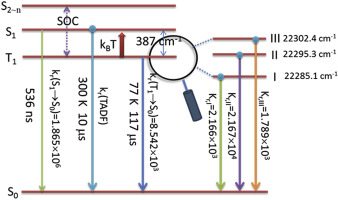Organic Electronics ( IF 3.2 ) Pub Date : 2020-02-27 , DOI: 10.1016/j.orgel.2020.105667 Lingling Lv , Kun Yuan , Changdai Si , Guofang Zuo , Yongcheng Wang

|
Investigations of the detailed photophysical processes are of great significance for future material improvements and novel designing strategies. Herein, the interconversion and decay rates of the first excited singlet state (S1) and triplet state (T1) for the Cu2I2(PˆN)3 complex are calculated using the thermal vibration correlation function (TVCF) theory, combined with the optimally tuned range-separated hybrid functional (OT-ωB97XD) method at different temperature. A methodology with the building different ONIOM models, was carried over into simulation of crystal environment. All calculated results perfectly match the experimentally available data, demonstrating the validity of our applied theoretical approach. It has been found that the reverse intersystem crossing (RISC) rate kRISC from T1 to S1 is 3.11 × 1010 s−1 at 300 K, about 7 order of magnitude larger than the phosphorescence rate kr(T) = 3.71 × 103 s−1, and far more than ISC rate kISC(T1-S0) of 6.38 s−1. The S1 state can be an efficient thermal population from the T1 state by the RISC pathway, leading to an occurrence of thermally activated delayed fluorescence (TADF), and the estimated delayed time of τ(TADF) = 10 μs. On the other hand, the T1 state also exhibits stronger admixtures with higher lying singlet states due to stronger SOC, having a larger ZFS of 17 cm−1, thus, a relatively fast phosphorescence decay rate of kr(T) = 8.542 × 103 s−1 estimated by Einstein emission formula is observed. Further calculation results show that the emission intensities are stemming by 91% from the S1 state as TADF and by 9% as phosphorescence from the T1 state at 300 K, which indicates the ambient temperature emission represents the combined luminescence of TADF and phosphorescence. Our work would be useful for improving and designing the luminescent material combined high-efficiency TADF with phosphorescence.
中文翻译:

QM / MM结合最佳调谐范围分离杂化功能研究双核铜(I)分子晶体中TADF和磷光的机理
详细的光物理过程的研究对于未来的材料改进和新颖的设计策略具有重要意义。这里,Cu 2 I 2(PˆN)3的第一激发单重态(S 1)和三重态(T 1)的互变和衰减率。使用热振动相关函数(TVCF)理论,结合最佳调谐范围分离混合函数(OT-ωB97XD)方法,在不同温度下计算复合体。建立了不同的ONIOM模型的方法被带入了晶体环境的仿真中。所有计算结果均与实验可得数据完全匹配,证明了我们应用的理论方法的有效性。已经发现, 在300 K时,从T 1到S 1的反向系统交叉(RISC)速率k RISC为3.11×10 10 s -1,比磷光速率k r(T)= 3.71大大约7个数量级。×10 3s -1,并且远远超过6.38 s -1的ISC速率k ISC(T 1 -S 0)。S 1状态可以是通过RISC途径从T 1状态开始的有效热种群,从而导致热激活延迟荧光(TADF)的发生,并且估计的延迟时间τ(TADF)= 10μs。另一方面,由于SOC较强,T 1状态还表现出较强的掺混物和较高的单线态,ZFS较大,为17 cm -1,因此磷光衰变速率相对较快,k r(T)= 8.542× 10 3 s -1由爱因斯坦发射公式估算。进一步的计算结果表明,在300 K时,S 1状态的发光强度为TADF,而T 1状态的发光强度为9%,这表明环境温度发光代表TADF和磷光的组合发光。我们的工作对于改进和设计结合了高效率TADF和磷光的发光材料将是有用的。



























 京公网安备 11010802027423号
京公网安备 11010802027423号